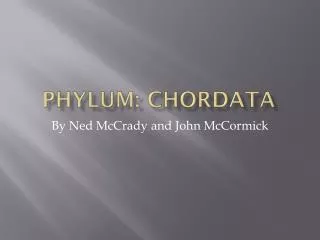
Phylum Chordata. A Chordate is an animal that has 4 specific characteristics during their life cycle: 1- Dorsal, hollow nerve cord 2- Notochord – a long supporting rod that runs through the body below the nerve cord 3- Post anal tail 4-Pharyngeal pouches (gill slits).

atira + Follow
Download PresentationAn Image/Link below is provided (as is) to download presentation Download Policy: Content on the Website is provided to you AS IS for your information and personal use and may not be sold / licensed / shared on other websites without getting consent from its author. Content is provided to you AS IS for your information and personal use only. Download presentation by click this link. While downloading, if for some reason you are not able to download a presentation, the publisher may have deleted the file from their server. During download, if you can't get a presentation, the file might be deleted by the publisher.

Phylum Chordata. A Tribute to the Diversity We Know. Introduction. Members of the Phylum Chordata include animals with which we are probably most likely familiar (including fish, birds, reptiles, amphibians and beasts like ourselves)
3.05k views • 54 slides

Phylum Chordata. Subphylum Vertebrata. Subphylum Vertebrata. Fishes. Chapter 8. Subphylum Vertebrata. *Cranium. *Vertebrae. Larvae of a jawless fish. Skeletal elements of a jawless fish. Subphylum Vertebrata. Jawless Fishes. Jawless Fishes – ancient diversity. Jawless fish: Hagfish.
1.79k views • 74 slides

Phylum Chordata. Protostome vs. Dueterostome Development Chordates and Echinoderms have deuterostome development, and so are considered related.
1.45k views • 17 slides

Phylum Chordata. Subphyla Invertebrata & Vertebrata from sea otters to sea squirts. Chordates. pharyngeal slits - a series of openings that connect the inside of the throat to the outside of the "neck". These often, but not always, become the gills.
843 views • 32 slides

Characteristics of chordates. Notochord: firm flexible rod of specialized cells located in the dorsal part of the bodyIn most vertebrates it appears only during embryonic stage and is replaced by vertebral columnDorsal nerve cord: hollow tube just above the notochordPharyngeal pouches: small o
198 views • 5 slides

Phylum Chordata. Chondrichthyes. Sharks and rays Cartilaginous fishes Ectothermic Denser than water. Osteichthyes. Bony fishes Ectothermic. Osteichthyes. Swim Bladder provides buoyancy Connected to digestive tract in lungfishes. Amphibia. Amphibia. Metamorphosis “Double Life”
396 views • 16 slides

Phylum: Chordata. By Ned McCrady and John McCormick. Chordates. Defining Characteristics: Coelomates that have a notochord; a dorsal, hollow nerve cord; pharyngeal slits; and a muscular, post anal tail. Other Characteristics. All organisms in this phylum are deuterostomes .
246 views • 3 slides

Phylum Chordata. Order Orectolobiformes. Mouth completely in front of eyes Both dorsal fins without spines Five pairs of gill slits Anal fin present Broad snout . Family Ginglymostomatidae. two spineless, rounded dorsal fins with the first dorsal fin much larger than second
298 views • 6 slides

Phylum Chordata. SBI 3U. What are Chordates?. Chordates are animals with a nerve cord, notochord and gill slits (at least at some point in their lives). Characteristics of Chordates. Bilaterally symmetrical Ventral heart Body extends past anus into a tail Nerve cord Notochord
310 views • 12 slides

Phylum Chordata. SBI 3U October 29 th , 2012. What are Chordates?. Chordates are animals with a nerve cord, notochord and gill slits (at least at some point in their lives). Characteristics of Chordates. Bilaterally symmetrical Ventral heart Body extends past anus into a tail
281 views • 12 slides

Phylum : CHORDATA. WHAT IS A CHORDATE. To be classified into this Phylum, members must have the following characteristics at some point in their development. 1. Hollow Dorsal Nerve Cord. Nerve Cord is now found toward the DORSAL surface of the body rather than Ventrally.
2.83k views • 12 slides

Phylum Chordata. Ch. 34. Characteristics. Notochord Dorsal, hollow nerve cord Muscular post-anal tail Gill slits. Gills. Simple Chordates. Urochordata – tunicates Cephalochordata – lancelets. Challenges Faced. Chasing food Grabbing food when close Getting oxygen from environment
443 views • 29 slides

Phylum Chordata. Phylum Chordata. Includes 5 Classes Fish Amphibians Reptiles Birds Mammals. Fish. Habitat : nearly every aquatic environment Respiration : use gills to breathe Circulation : 2 chambered heart Reproduction : sexual (mostly external)
1.09k views • 19 slides

PHYLUM CHORDATA. Depok, 11 April 2010. Bagan Klasifikasi. Phylum Chordata. Urochordata. Vertebrata. Cephalochordata. Agnatha. Gnathostomata. Chondricththyes. Osteicththyes. Amphibia. Reptilia. Aves. Mamalia. Urochordata. Cephalochordata. Lamprey. Hagfish. Agnatha.
832 views • 20 slides

Phylum Chordata. 45,000 species found throughout the world in nearly every habitat. General characteristics. 1. bilaterally symmetrical, deutersostomate animals deuterostome – an animal whose mouth develops from cells other than those at the opening of the gastrula.
389 views • 16 slides

Phylum Chordata. Subphylum Urochordata – Subphylum Cephalochordata – Subphylum Vertebrata – 48,000 species Range in size from tiny fish to huge whales Occupy all of Earth’s biomes. Craniates. 2 defining characteristics compared to nonvertebrate chordates
779 views • 48 slides

Phylum Chordata. SUBPHYLUMS Three Types. #1 Urochordata (Tunicates and Seaquirts) Considered as the invertebrate chordata As an adult they have an reduced nervous system and loss notochord No definite head Filter feeders. #2 Cephalochordata (lancelets)
338 views • 10 slides

Phylum Chordata. Notochord…flexible rod that gives support during development Usually disappears when backbone develops. Lancet. Subphylum Vertebrata. Vertebrae (backbone ) made of bone or cartilage Skull that protects the brain Endoskelton made of bone or cartilage. Fish.
435 views • 24 slides

Phylum Chordata. Notochord in embyronic stage Dorsal hollow nerve cord Pharyngeal slits Muscular, post anal tail. Tunicates: Urochordata. most primal form of all vertebrates pharyngeal gill slits Dorsal nerve cord notochord separate mouth and anus. Circulatory System.
773 views • 58 slides

Phylum Chordata. --Invertebrate chordates: tunicates and lancelets. --Vertebrate chordates: fishes, amphibians, reptiles, birds, mammals. Characteristics (embryonic development). Dorsal hollow nerve cord Notochord—firm flexible supporting rod located just below the nerve cord
618 views • 37 slides

Phylum Chordata. Fish. I. Phylum Chordata. Includes Fish, Reptiles, Birds and Mammals A. Characteristics of Chordates 1. All have bilateral symmetry 2. All have internal skeleton 3. Notochord – Flexible internal, supporting structure; “backbone”.
646 views • 42 slides